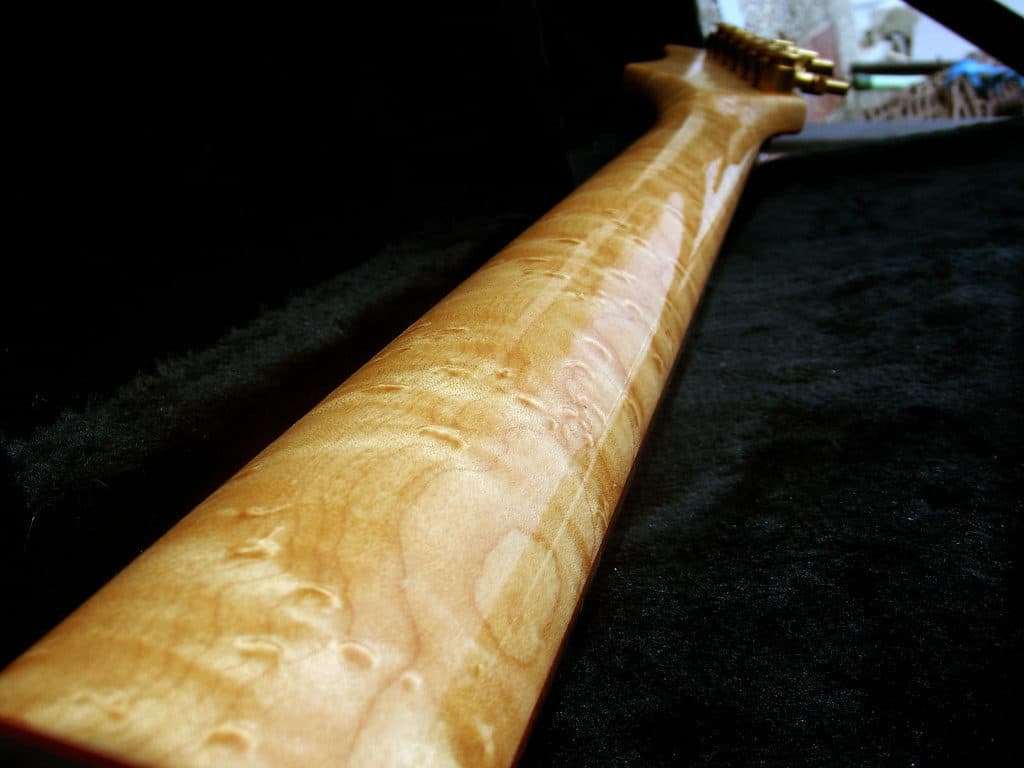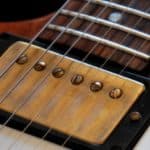The neck of a guitar is probably one of the most important parts, if not the most important, this instrument has.
You see, here is where your fretting hand will rest and grip when you are playing. I know I’m not telling you anything new, but I think it’s important to emphasize this.
Many players will choose guitars completely based on the profile of their neck.
So if this is so important to that many people, maybe it is time to learn a bit more about the different guitar neck shapes there are out there.
The shape of a guitar’s neck has an impact on its tone, as well as on its playability. Sound is not influenced by the shape itself, but by the mass it has. More massive necks sound fuller and have more sustain. Less massive ones sound brighter and open. Thickness is a defining factor for playability.
For those who want a deep dive into this topic, in this article, I will talk about how do these different guitar neck shapes affect tone.
After that, I will talk briefly about the most common shapes you are likely to find out in the wild, and I will answer some of the most common questions many players ask about them.
Finally, I will give you my conclusions and recommendations about how to approach different guitar neck shapes when picking a new instrument.
Are you ready to get started?
Let’s go!
Do guitar neck shapes affect tone?
Guitars are complex systems in which every factor matters. Neck shape probably does not have a significant impact on tone, however, the actual mass of the neck does. More massive necks will sound fuller, warmer even, and have more sustain. Lesser massive necks will sound open, brighter, and resonate more.
Rather than the actual profile, if tone matters to you, you should be thinking about how much wood does the neck adds to your instrument and how dense is it. Remember hardwoods are denser than softwoods.
As an anecdote, and don’t quote me on this, I once read that when Steve Vai was working with Ibanez into designing his signature guitar, he tried out many different necks.
In his opinion, thicker necks sounded better, however, thinner ones were more comfortable to play with.
He ended up choosing comfort.
How much do guitar neck shapes affect tone?
Quantifying how much a certain aspect of a guitar influences its tone is no easy task. It would require extensive scientific research to arrive at conclusive results.
What I can offer you is empirical evidence, based on the opinion of many players.
Neck shape, or rather neck mass, will have an effect on how the overall instrument sounds, however, I will argue that a neck reprofiling will not be as impactful in tone as getting a neck with the same profile made of an absolutely different tonewood.
There are certain things such as tonewoods, construction type, pickups, and I may be missing some others, that have a way greater impact on a guitar’s tone.
Does neck shape have an impact on playability?
Neck shape does have a big impact on the playability of the instrument. This is probably the most personal feature of a guitar. Different players have different hands and play styles. What feels great for some might be awful for others.
Small-handed people will probably prefer thinner necks, while big-handed individuals will likely enjoy thicker necks, but this is not set on stone.
It will also depend on how you position your hand while playing.
If you usually wrap your thumb around the neck and even use it to fret the 6th string, a thinner neck might benefit your playstyle.
On the other side, if you are someone who prefers a full grip of the neck at every time, a thicker alternative might suit you better.
What I’m trying to say here is that you should try out as many neck profiles as you can and see what works out better for you.
Most common guitar neck shapes and their effect on playability and tone
Although different brands choose to name the neck profiles they use on their instruments differently, because of marketing, shapes are limited and could be reduced to the following 5 categories:

“U” shape necks
These kinds of profiles are more common on thicker necks and they are called “baseball bat” necks by older players.
In terms of playability, this profile favors players with bigger hands and those who like playing with their thumbs on the back of the neck.
Smaller-handed guys like me will probably have a harder time getting used to this one.
These kinds of profiles are also said to be more resilient to bending when exposed to changes in weather.
In terms of tone, as with any massive neck, you will find some extra warmth and sustain.
Some popular instruments that have used this type of profile are:
- Fender Nocaster
- Fender Telecaster
- Gibson Les Paul Gold Top
“V” shape necks
V shapes come in different flavors, varying in how pronounced the actual V is.
These kinds of necks are considered old school and are not very popular in modern instruments.
In terms of playability, it is said that V profiles favor the over-the-top thumb-wrapping individuals. And I can see that.
In terms of tone, it will depend on the actual mass of the neck you’re playing. V necks tend to be on the more massive side, so expect extra sustain and a fuller tone.
Some popular instruments that have used this type of profile are:
- ‘56 Stratocasters
- ‘60s Stratocasters
- SRV Stratocasters
“C” shape necks
The C shape is the most common neck profile on the market nowadays. It has many variations, however.
C necks tend to be rounded into an oval, and its design appeals to many different kinds of players.
In terms of playability, this neck profile is fast, and on the thinner side, so smaller-handed players will probably be happy with it.
However, as mentioned earlier, there are many different derived shapes from extra-slim to huge. So there’s something for everyone.
Since its most common form is rather thin, I will say that because of this, this kind of neck might be more likely to warp under changes in weather.
In terms of tone, the thinner options will sound more open, bright, and be resonant.
Some popular instruments that have used this type of profile are:
- American Vintage Stratocasters
- ‘62 Stratocasters
- Ibanez Super Wizard necks
- Ibanez JEM
- ‘59 Gibson SGs
“D” shape necks
Also known as “modern flat oval” is, as its name implies a more recent popular neck profile.
It is very similar to the C shape, however, D-shaped neck profiles have flatter edges.
This shape feels almost flat on the back and is very comfortable in the hands of the player. It is a flatter alternative for those who hate curves.
In terms of playability, a flatter profile means speed and smoothness to shift between strings. This is why many modern companies decided on this shape for many of their new models.
In terms of tone, D neck profiles are probably the thinnest of the bunch, this meaning: less mass, a brighter, more resonant open tone.
Some popular instruments that have used this type of profile are:
- Ibanez JP20
- Ibanez GB10
- Epiphone Sheraton
- Epiphone Les Paul Standard
Asymmetrical necks
Asymmetrical neck shapes are not that common, ok, but this is an honorable mention since I think they are awesome.
As its name implies, this kind of neck shape combines 2 profiles in one. Usually, the low E side is thicker, and it gets thinner on the high E side.
This controversial design allows for the thickest part of the neck to be in contact with the palm of the hand while the thinnest extreme is where the fingers lay.
It’s the best of both worlds for some, and a nightmare for others.
Eddie Van Halen was known for using this neck shape.
In terms of playability, you could expect some getting used to it, but if you are a match for this shape you would never like any other better.
In terms of tone, I would consider this a rather neutral alternative, since its thicker side compensates for its thinner one.
Some popular instruments that have used this type of profile are:
- EVH Wolfgang Standard
- 2018 Gibson Les Paul HP
How to find out a guitar’s neck shape?
The best way to find out what’s the shape of a guitar’s neck is to run your hand down it and try to feel how curved it is. If you feel a rather flat back, it’s probably a D shape. A pointy center will mean a V shape. A thick rounded profile will mean a U shape, and a more thin round one will be a C shape.
How to pick a guitar neck shape?
There is no rule for picking a guitar’s neck shape. You will have to try out many different ones until you find a match and then iterate over similar ones. A rule of thumb is that smaller hands will probably be more comfortable con C or D shapes, while larger hands will likely prefer U or V profiles.
Which guitar neck shape is best?
There is no neck profile better than the others, at least in general. The best neck shape out there is the one that feels more comfortable to you. Tone is not as important as playability for neck profiles. The most used shapes nowadays, if that matters, are C and D, so there’s a starting point for you.
Which guitar neck shape is best for small hands?
Players with smaller hands will probably feel more comfortable with D-shaped necks or C profiles since they are thinner and will allow them to have a better grip. Even asymmetrical alternatives could work out, however, these are not as common. You shouldn’t rule out thicker profiles anyway. Try them all.
Which guitar neck shape is easier to play?
The easiest neck shapes to play are probably C and D profiles, and that’s why many popular brands gravitate towards them. They are slim, fast, and versatile. Only players with larger hands could feel them not as comfortable and perhaps prefer a thicker alternative. However many will still prefer these.
Which is the best guitar neck shape for beginners?
Beginners need to get used to the feel of gripping a guitar’s neck and there’s no better alternative for this than something manageable as a C shape. D profiles are also advised, however, their flatter back might not be that comfortable over extended practice sessions. Please stay away from V necks.
What does a fast neck mean?
A fast neck, in most cases, means a slimmer neck, with a profile such as C or D, that allows the player to perform fast-moving passages and jumping between strings without getting in the way. Thicker necks are not considered as fast, since they are usually more in contact with the player’s hand at all times.
Conclusion and recommendations
Whether you are looking for a new guitar or planning on building or having one built, getting to know, at least at a high level how guitar necks work is, in my opinion, something that will help you make a better informed final decision.
However, here in GearAficionado, I always say that you should try out every instrument before buying it if you have the chance.
I don’t think anyone can really understand the sound and feel of all these different guitar neck shapes without getting to play them live. At least try the ones that you think might work out better for you.
If it’s within your reach, try to get to play completely different guitars to clearly understand where the variation lies, and then start checking out ones closer to the one you preferred the most.
Finally, don’t forget to have fun. Technicalities for some people get the joy out of getting a new piece of gear. You don’t have to know it all about something that makes you smile. Just go and play the instrument that feels best to you.

Hello there, my name is Ramiro and I’ve been playing guitar for almost 20 years. I’m obsessed with everything gear-related and I thought it might be worth sharing it. From guitars, pedals, amps, and synths to studio gear and production tips, I hope you find what I post here useful, and I’ll try my best to keep it entertaining also.





